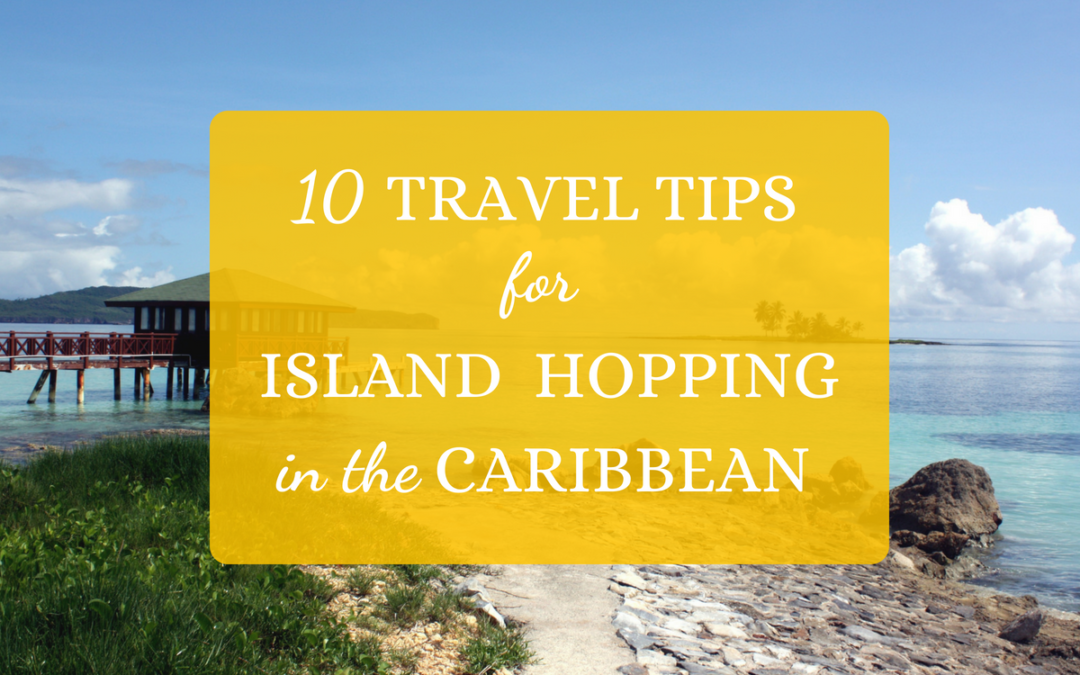When looking at a map of the Caribbean, it’s natural to want to explore. The prospect of island hopping and experiencing a variety of rocks sounds exciting and fun. So many islands in such a small geographic space – it should be easy, right? Not quite.
Anyone who has engaged in island hopping in the Caribbean is all too familiar with the frustrations that come when attempting to book tickets from rock to rock. The schedules are limited, many islands are seemingly inaccessible, and the prices can be shocking. You would think that a 30 – 45 minute plane ride would be cheap. But all it takes is traveling a few times in the region to discover that “cheap” is a relative term.
So how can you successfully plan an island-hopping trip in the Caribbean considering all of the obstacles above?
As an island girl who is so often on the move, I have a few insights to share. Here are my 10 tips to help you plan an island hopping trip in the tropics that is as inexpensive, fun, and hassle-free as it can be:

1. Plan your route wisely
While your first instinct in planning an island hopping trip may be to simply travel from one island to the nearest subsequent island along the chain, keep in mind that this does not always provide you with the cheapest options. Island airlines plan their routes based on several factors, demand being one of them. Therefore if the island you are thinking of traveling to is not a popular one, the airline will most likely fly over it, stopping at other islands first, before you’d eventually land there. I once traveled to Guadeloupe and the only flight available at the time involved flying over the island not just once, but twice, before we actually landed there.
2. Book early
There are several different beliefs regarding what is considered “early” when booking flights. The travel website Hopper.com advises that the cheapest flights to Caribbean islands are available 25 days in advance. However, their recommendation is based on flights from the United States and Europe. If you are traveling within the Caribbean on a Caribbean-based airline, you are less likely to benefit from “flash sale” seats closer to your travel date. Flights should be booked at least two to three months in advance (if possible) to benefit from discounted, restricted fares before they are all sold out.
3. Explore different airlines
There are two main airlines serving the Caribbean region – Liat Airlines and Caribbean Airlines. Then there are other airlines that service relevant groups of islands based on language. Air Carïbes flies throughout the French Caribbean, while Insel Air flies to the Dutch Caribbean islands. Copa Airlines flies mainly to Spanish-speaking countries, while Cayman Airways, Cubana de Aviación, and Bahamas Air service their relevant countries along with larger carriers. Keep these smaller airlines in mind when searching for travel options within the islands.

4. Take the Caribbean ferries
Many island chains offer ferries between Caribbean islands as an alternative to flying within their own regions such as the British and US Virgin Islands, the Bahamas, St. Vincent and the Grenadines, and twin island states such as Trinidad and Tobago, Antigua and Barbuda, and St. Kitts and Nevis. For travel between many of the major islands, L’Express Des Iles is the largest ferry service operating in the Caribbean. It traverses the Caribbean waters from Guadeloupe to St. Lucia, making stops to the islands in between. It is definitely the most affordable option to travel between these islands, with one rate offered regardless of how far up or down the chain of islands you travel.
5. Check out guest houses when staying over
The advent of hostels, couch-surfing, and Airbnb have taken the travel world by storm. They offer affordable options to budget-friendly travelers and those wishing to interact with locals rather than being confined by hotel walls. Unfortunately, these are not widely available throughout the Caribbean. Although some of these options are available on the more developed islands, there are far more islands where a guest house is the most affordable option still. Guest houses vary in price and amenities, however, they are still cheaper than staying at hotels and you can interact with the locals who operate these establishments.
6. Take carry-on only
I am a major advocate for packing carry-on only for trips whenever you can, especially in the Caribbean. Not all island airlines in the Caribbean have mastered the seamless logistics of the larger airlines elsewhere. Reports of lost and delayed luggage by airlines in the Caribbean are all too common, often caused by the number of stops and connections a traveler might endure on their island-hopping trip. Taking carry-on only eliminates the possibility of lost or delayed luggage. Just be mindful of the individual airlines’ carry-on size limits, as they may have restrictions in place that require smaller hand luggage compared to larger airlines.

7. Maximize your layovers
Layovers are a common aspect of travel – especially while island hopping – but they don’t have to be boring. Some island airports offer a wide variety of duty-free shopping options, while others are very restricted. Depending on the amount of time you have, you can also take a trip to the town or the beach before taking your next flight to the next island. Be sure to check out the options at the layover airports in advance, as well as the ease of commuting to nearby attractions when planning your trip.

8. Pack a light sweater or jacket for your island travel days
Picture this: you are dressed for your Caribbean vacation in shorts and a cotton shirt, you enter the open, breezy check-in area, and you think you are all set. But once you get through Immigration, you are greeted by an onslaught of ice cold breeze that hits you in the face and flows all the way down to your exposed legs. And just like that, you’re freezing… in the Caribbean. Many Caribbean countries have maintained European-style uniforms from their colonial past. To make wearing these uniforms bearable, most offices and buildings such as airports maintain very chilly internal temperatures. Unfortunately, this does not bode well for travelers experiencing delayed flights and few options for warmth in the outfits they’d planned to wear in the typical tropical heat and humidity. When packing, keep in mind that Caribbean airports can be cold and walk with a light sweater or jacket when traveling by air from rock to rock.

9. Learn some of the native language
Although most of the Caribbean speaks English, on islands where English is not the native language (unlike most European countries) they do not always offer English translations on signs and documents. Furthermore, each island has its own dialect that can make things confusing even for a visitor who speaks their native language. Before you travel, learn a few key words in both the native language and their dialect to help smooth along your travel days.
10. Be prepared for delays
If you are planning a trip to several different islands, there is a great possibility that you will experience delays. This has to do with the logistical challenges identified earlier, as well as weather changes. As most island airlines use small planes, flying through bad weather is rarely practiced. Severe changes in weather can therefore cause flight delays, having a ripple effect on future connections. Keeping this inevitability in mind can help minimize disappointment if you have contingency plans in place in the event of delays. Be prepared for anything and you will be surprised by nothing.

Happy rock-hopping, islanders!
– – –
Do you have any island-hopping travel hacks for the Caribbean or other rock regions?














